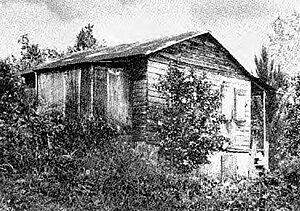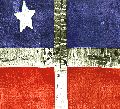Manuel Rojas Luzardo facts for kids
Quick facts for kids
Manuel Rojas
|
|
|---|---|
 |
|
| Born | 1831 City of Obispos in the state of Barinas, Venezuela |
| Died | October 14, 1903 City of Boconó in the state of Trujillo, Venezuela |
| Allegiance | Puerto Rico |
| Service/ |
"Revolution Committee of Puerto Rico" |
| Rank | Commander |
| Commands held | Puerto Rican Liberation Army |
| Battles/wars | El Grito de Lares |
Manuel Rojas Luzardo (1831 – October 14, 1903) was a brave leader from Puerto Rico and Venezuela. He was a commander in the Puerto Rican Liberation Army. Manuel Rojas helped lead the Grito de Lares uprising. This was a fight against Spanish rule in Puerto Rico.
Contents
Early Life and Moving to Puerto Rico
Manuel Rojas Luzardo was born in 1831. His birthplace was Obispos, a city in Barinas, Venezuela. His father was from Puerto Rico, and his mother was Venezuelan. Manuel went to school in Venezuela.
He worked hard in farming. After saving money, he moved to Valencia, Spain. There, he became a successful businessman. Venezuela's economy was difficult in the early 1800s. So, Rojas decided to move to Puerto Rico. He met and married Obdulia de los Ríos there.
The Rojas family settled near the town of Lares. This area was mountainous. People there mostly grew coffee. Manuel and his brother, Miguel, bought a large coffee farm. It was about 300 acres.
Their farm was called "El Triunfo." Both brothers became wealthy merchants. Miguel met Mariana Bracetti during a business trip. She was from Añasco. Miguel and Mariana married. They moved to "El Triunfo" to live with Manuel's family.
Fighting for Puerto Rico's Freedom
Manuel Rojas admired Ramón Emeterio Betances. Betances wanted Puerto Rico to be free. Manuel and his brother Miguel joined Betances. They worked together for Puerto Rico's independence.
A group called the "Revolution Committee of Puerto Rico" was formed. Betances and Segundo Ruiz Belvis led it. They were living outside Puerto Rico in the Dominican Republic. Several secret groups were set up. These groups were in towns in western Puerto Rico. They were ready to help Betances' planned invasion.
Two important secret groups were formed. One was in Mayagüez. Its leader was Mathias Brugman. Its code name was "Capa Prieto." The other group was in Lares. Its code name was "Centro Bravo." Manuel Rojas led this group.
"Centro Bravo" was the main meeting place. It was located on the Rojas family farm. Betances named Manuel Rojas the "Commander of the Liberation Army." Mariana Bracetti, Miguel's wife, was also important. She was named "Leader of the Lares Revolutionary Council." Betances asked her to make a special flag. This was the revolutionary Flag of Lares, also known as "La Bandera de Lares."
The Revolutionary Committee chose twelve generals. Manuel Rojas was the Commander in Chief.
The Spanish government found out about the plan. They stopped the ship Betances had. This ship was carrying weapons for the invasion. The mayor of Camuy, Manuel González, was also a rebel leader. He was arrested for treason. He learned that the Spanish army knew about the plan. He escaped and warned Manuel Rojas.
The Uprising: El Grito de Lares
Because of this warning, the rebels decided to act quickly. They set the uprising for September 23, 1868. Mathias Brugman and his men joined Manuel Rojas's group. About 800 men and women marched. They took over the town of Lares. This event is known as "El Grito de Lares."
The rebels went into the town's church. They placed the revolutionary flag, made by Mariana Bracetti, on the main altar. This showed that the revolution had begun. They declared Puerto Rico a new country. They called it the "Republic of Puerto Rico." Francisco Ramírez Medina was named its first President.
Rojas and his followers then marched to San Sebastián. They were not well-armed. They mostly had clubs and machetes. The Spanish Army knew they were coming. The Spanish soldiers were waiting with better weapons. When the rebels arrived, they faced heavy gunfire.
The uprising failed. Many rebels were killed. At least 475 people were arrested. This included Manuel Rojas and Mariana Bracetti. They were held in the jail in Arecibo. They were sentenced to death. Some rebels managed to escape and hide.
What Happened Next
Manuel Rojas was arrested in October. A military court sentenced him to death. Eugenio María de Hostos was a Puerto Rican leader. He led a group that helped the rebels. They met with the Spanish President, Francisco Serrano. They asked for Rojas and the others to be pardoned. They wanted the death sentences to be stopped.
President Serrano said he would pardon Puerto Rican natives. But he was hesitant to pardon foreigners. He was referring to Rojas, who was born in Venezuela. However, de Hostos argued that Rojas was like a son of Puerto Rico. He had moved there young and made it his home. So, he should have the same rights.
The new governor of Puerto Rico, Jose Sanz, received orders. The new Spanish government granted a general pardon. This pardon was for all those imprisoned. It became effective on September 20, 1869. Manuel Rojas and some other rebels were sent away from Puerto Rico.
Rojas was sent to Venezuela. He lived in Boconó, a city in the state of Trujillo. Not much is known about his life after exile. He passed away on October 14, 1903, in Boconó.
On December 25, 2002, Puerto Rico passed a special law. Public Law #291 asked the Institute of Puerto Rican Culture to study something important. They were to look into moving Manuel Rojas's remains back to Puerto Rico. Many people see him as one of Puerto Rico's greatest independence leaders.
Legacy
A school in Bartolo, Lares, Puerto Rico is named after Manuel Rojas.
See also
 In Spanish: Manuel Rojas (revolucionario) para niños
In Spanish: Manuel Rojas (revolucionario) para niños
- List of Puerto Ricans
- List of Puerto Rican military personnel



